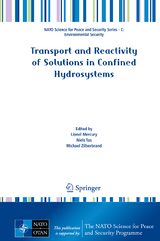Transport and Reactivity of Solutions in Confined Hydrosystems
Expert contributors from Israel, Russia, Europe and US discuss the behaviour of water and aqueous solutes at different scale, from the nanometric range of carbon nanotubes and nanofluidics to the regional scale of aquifers reactive flow in sedimentary basins. This scientific scope allowed the group of participants with very different background to tackle the confinement topic at different scales. The book is organized according to four sections that include: i) flow, from nano- to mega-scale; ii) ions, hydration and transport; iii) in-pores/channels cavitation; iv) crystallization under confinement. Most of contributions relates to experimental works at different resolution, interpreted through classic thermodynamics and intermolecular forces. Simulation techniques are used to explore the atomic scale of interfaces and the migration in the thinnest angstrom-wide channels.
Confined water in complex networks: unifying our understanding of pore water and solutes at all scales.- Interactions in water across interfaces: from nano to macro-scale perspective.- Theme 1: Flow, from nano- to mega-scale.-Confined water in carbon nanotubes and its applications.- Static and dynamic capillarity in silicon based nanochannels.- Confined water in saturated and non-saturated media: Infrared signature and thermodynamic properties.- Interchange of Infiltrating and Resident Water in Partially Saturated Media.- Impact of heterogeneity on evaporation from bare soils.- Theme 2: Ions, Hydration and Transport.- Enhanced Ion Transport in 2-nm Silica Nanochannels.- Ionic and Molecular Transport through Graphene Membranes.- Molecular structure and dynamics of molecular water: computer simulations of aqueous species in clay, cement, and polymer membranes.- Two generalizations of the theory of seismoelectric effect: Parameterization providing suitability of Frenkel's theory for any geometry of soil's pore space. The role of thermoosmosis in seismoelectric effect.- Theme 3. In-channels/pores cavitation.- Evaporation-Induced Cavitation in Nanofluidic channels: Dynamics and Origin.- Electrocavitation in nanochannels.- Stability and negative pressure in bulk and confined liquids.- Experimental superheating and cavitation of water and solutions at spinodal-like negative pressures.- Plant water transport and cavitation.- Theme 4: Crystallization under confinement.- Crystal growth and phase equilibria in porous materials.- Shaping the interface - interactions between confined water and the confining solid.- Geochemistry of capillary hydrogeochemical systems in arid environments.- Evaporation from a porous medium in the presence of salt crystallization.- Micro-CT analysis to explore salt precipitation impact on porous media permeability.- Reactive Transport in Heterogeneous Media.- Extraction of water from the atmosphere in arid areas by employing composites "a salt inside a porous matrix”.
| Erscheint lt. Verlag | 2.12.2013 |
|---|---|
| Reihe/Serie | NATO Science for Peace and Security Series |
| Zusatzinfo | 34 Illustrations, color; 64 Illustrations, black and white; XVII, 268 p. 98 illus., 34 illus. in color. |
| Verlagsort | Dordrecht |
| Sprache | englisch |
| Maße | 155 x 235 mm |
| Themenwelt | Naturwissenschaften ► Biologie ► Ökologie / Naturschutz |
| Naturwissenschaften ► Chemie ► Physikalische Chemie | |
| Naturwissenschaften ► Geowissenschaften ► Geologie | |
| Naturwissenschaften ► Physik / Astronomie ► Thermodynamik | |
| Technik ► Umwelttechnik / Biotechnologie | |
| ISBN-13 | 9789400775336 / 9789400775336 |
| Zustand | Neuware |
| Informationen gemäß Produktsicherheitsverordnung (GPSR) | |
| Haben Sie eine Frage zum Produkt? |
aus dem Bereich




